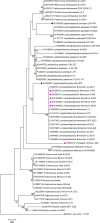Functional characterization of α-Gal producing lactic acid bacteria with potential probiotic properties
- PMID: 35524154
- PMCID: PMC9075922
- DOI: 10.1038/s41598-022-11632-8
Functional characterization of α-Gal producing lactic acid bacteria with potential probiotic properties
Abstract
The possibility of exploiting the human immune response to glycan α-Gal for the control of multiple infectious diseases has been the objective of recent investigations. In this field of research, the strain of Escherichia coli O86:B7 has been at the forefront, but this Gram-negative microorganism presents a safety concern and therefore cannot be considered as a probiotic. To address this challenge, this study explored the identification of novel lactic acid bacteria with a safe history of use, producing α-Gal and having probiotic potential. The lactic acid bacteria were isolated from different traditionally fermented foods (kununn-zaki, kindirmo, and pulque) and were screened for the production of α-Gal and some specific probiotic potential indicators. The results showed that Ten (10) out of forty (40) [25%] of the tested lactic acid bacteria (LAB) produced α-Gal and were identified as Limosilactobacillus fermentum, Levilactobacillus brevis, Agrilactobacillus composti, Lacticaseibacillus paracasei, Leuconostoc mesenteroides and Weissella confusa. Four (4) LAB strains with highest levels of α-Gal were further selected for in vivo study using a mouse model (α1,3GT KO mice) to elucidate the immunological response to α-Gal. The level of anti-α-Gal IgG observed were not significant while the level of anti-α-Gal IgM was lower in comparison to the level elicited by E. coli O86:B7. We concluded that the lactic acid bacteria in this study producing α-Gal have potential probiotic capacity and can be further explored in α-Gal-focused research for both the prevention and treatment of various infectious diseases and probiotic development.
© 2022. The Author(s).
Conflict of interest statement
The authors declare no competing interests.
Figures




Similar articles
-
Diversity and Probiotic Potential of Lactic Acid Bacteria Isolated from Horreh, a Traditional Iranian Fermented Food.Probiotics Antimicrob Proteins. 2018 Jun;10(2):258-268. doi: 10.1007/s12602-017-9282-x. Probiotics Antimicrob Proteins. 2018. PMID: 28527125
-
Characterization of potential probiotic starter cultures of lactic acid bacteria isolated from Ethiopian fermented cereal beverages, Naaqe, and Cheka.J Appl Microbiol. 2023 Nov 1;134(11):lxad237. doi: 10.1093/jambio/lxad237. J Appl Microbiol. 2023. PMID: 37858306
-
Probiotic activity traits in vitro and production of antimicrobial peptides by Lactobacillaceae isolates from pulque using Lactobacillus acidophilus NCFM as control.Braz J Microbiol. 2022 Jun;53(2):921-933. doi: 10.1007/s42770-022-00684-7. Epub 2022 Jan 29. Braz J Microbiol. 2022. PMID: 35094300 Free PMC article.
-
Advantages and disadvantages of non-starter lactic acid bacteria from traditional fermented foods: Potential use as starters or probiotics.Compr Rev Food Sci Food Saf. 2022 Mar;21(2):1537-1567. doi: 10.1111/1541-4337.12897. Epub 2022 Jan 13. Compr Rev Food Sci Food Saf. 2022. PMID: 35029033 Review.
-
How to select a probiotic? A review and update of methods and criteria.Biotechnol Adv. 2018 Dec;36(8):2060-2076. doi: 10.1016/j.biotechadv.2018.09.003. Epub 2018 Sep 26. Biotechnol Adv. 2018. PMID: 30266342 Review.
Cited by
-
Glycan-related genes in human gut microbiota exhibit differential distribution and diversity in carbohydrate degradation and glycan synthesis.Front Mol Biosci. 2023 Jun 15;10:1137303. doi: 10.3389/fmolb.2023.1137303. eCollection 2023. Front Mol Biosci. 2023. PMID: 37398549 Free PMC article.
-
Weissella cibaria Relieves Gut Inflammation Caused by Escherichia coli through Inflammation Modulation and Gut Microbiota Regulation.Foods. 2024 Apr 8;13(7):1133. doi: 10.3390/foods13071133. Foods. 2024. PMID: 38611436 Free PMC article.
-
An α-Gal antigenic surrogate as a biomarker of treatment evaluation in Trypanosoma cruzi-infected children. A retrospective cohort study.PLoS Negl Trop Dis. 2024 Jan 18;18(1):e0011910. doi: 10.1371/journal.pntd.0011910. eCollection 2024 Jan. PLoS Negl Trop Dis. 2024. PMID: 38236916 Free PMC article.
-
Exploring the relationship between Faecalibacterium duncaniae and Escherichia coli in inflammatory bowel disease (IBD): Insights and implications.Comput Struct Biotechnol J. 2023 Nov 19;23:1-9. doi: 10.1016/j.csbj.2023.11.027. eCollection 2024 Dec. Comput Struct Biotechnol J. 2023. PMID: 38094217 Free PMC article. Review.
-
Mechanistic insights into the interaction between the host gut microbiome and malaria.PLoS Pathog. 2023 Oct 12;19(10):e1011665. doi: 10.1371/journal.ppat.1011665. eCollection 2023 Oct. PLoS Pathog. 2023. PMID: 37824458 Free PMC article. Review.
References
Publication types
MeSH terms
LinkOut - more resources
Full Text Sources
Research Materials
Miscellaneous

